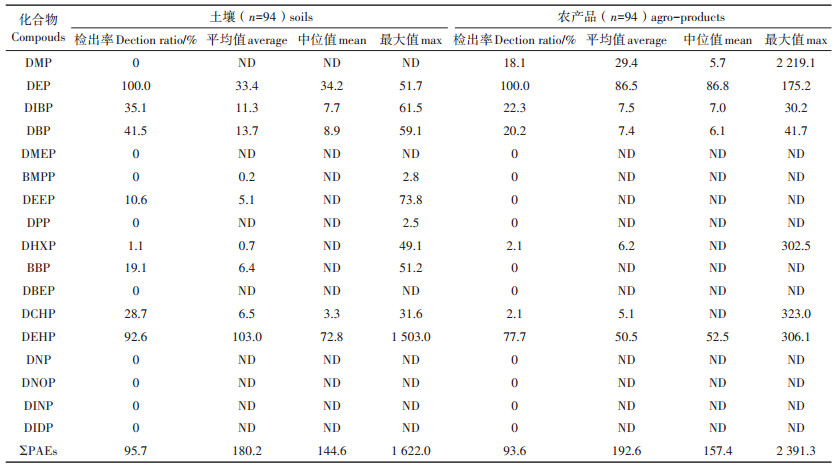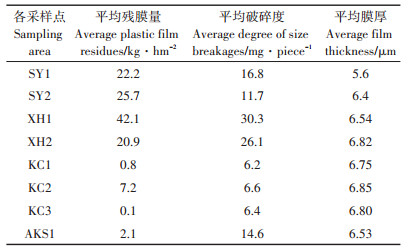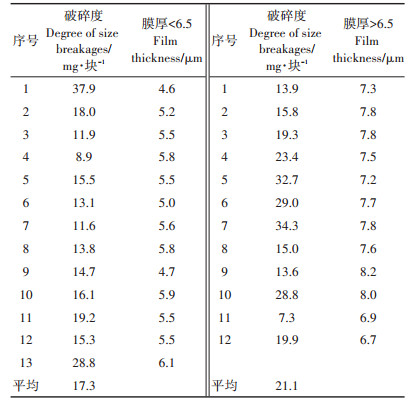苯二甲酸酯(Phthalate ester,PAEs)通常用于增加塑料制品的弹性、柔软性和可延展性[1],被广泛应用于日常塑料制品、化妆品、个人护理、食品包装和医疗用品[2]。邻苯二甲酸酯并未聚合到聚氯乙烯(PVC)高分子的碳链上,在使用过程中容易游离出来,大量使用含PAEs的产品导致空气、水、土壤和沉积物中都广泛检出此类污染物[3-5]。环境中的PAEs残留时间长且具有致癌、致畸和致突变[6-7],尤其对大鼠有胚胎毒性,具有抗雄性激素作用[8-10],美国EPA等机构将6种PAEs列入了环境优先控制污染物。土壤是PAEs等环境污染物的最主要的容纳载体,随着我国农业的现代化,农膜的使用量不断扩大,PAEs不断通过污水灌溉、施肥、农药和农地膜的使用等方式迁移到农业土壤中[11]。2015年我国农膜使用量280多万t[12],PAEs已经成为我国土壤中主要的污染物之一[13-17]。
新疆是我国棉花主产区,2014年新疆棉花种植面积已达197.8万hm2,覆膜率高达100%,2016年产量达359万t,约占全国总产量的67.3%[18]。棉花种植在促进地方农业经济发展的同时,栽培过程中使用大量农膜导致土壤中农膜残留量居高不下,地膜残留率在24%,是全国平均水平的4~5倍[19]。棉田地膜平均残留高达134.09 kg · hm-2[20],棉田土壤中多种PAEs检出并超出控制标准[21]。经过几年治理,残留量虽有所下降,但仍属我国土壤“白色污染”比较严重的区域。
近年来,新疆由于实行农业供给侧改革,种植结构调整,压缩棉花种植面积,2015年压缩40.9万hm2,2016年压缩10万hm2,改种小麦6.7万hm2、玉米7.9万hm2,种植加工番茄、加工辣椒、苜蓿、瓜果、葡萄、油料作物等特色经济作物18.5万hm2等等[22]。土壤中农膜残留过高可能导致PAEs经食物链迁移到人体中,累积过高对人体造成生殖毒性。
1 材料与方法 1.1 样品采集根据新疆棉花产业结构调整布局等因素确定采样点,采样点分布于阿克苏地区面积较大的农业生产基地,采集94个土壤表层样品。多点采样混合法采集土壤样品,将一定面积的农田采集10个点的土壤混匀后取1 kg装入布袋,采集土壤样品保存于-18 ℃冰箱备用。
图 1中黑色实心圆标出新疆阿克苏地区采样区域分布。沙雅县SY1、SY2,新和县XH1、XH2,库车县KC1、KC2、KC3,阿克苏市AKS1。
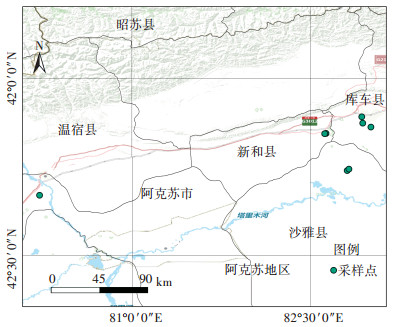
|
图 1 新疆阿克苏地区采样区域分布示意图 Figure 1 Sample distribution map of Akesu in Xinjiang Uygur Autonomous Region, China |
农产品样品采集在农作物成熟上市前进行,采集部位为农作物可食用部分,农产品样品采集与土壤采样点保持一致,分别采集4种以上的主要蔬菜品种(如:叶菜类、根茎类、茄果类和瓜果类等)、瓜果及核果类水果等,采集农产品94个,每个样品3 kg左右,装入布袋编号后迅速带回实验室粉碎匀浆装入食品级硅胶袋中,样品保存于-18 ℃冰箱备用。按照《农用地膜污染调查规程》采集农田残膜,洗净晾干后测定质量、面积等,膜厚采用膜厚测定仪(千分之一毫米规格)测定。
1.2 试剂17种PAEs标准品:邻苯二甲酸二甲酯(DMP),邻苯二甲酸二乙酯(DEP),邻苯二甲酸二异丁酯(DIBP),邻苯二甲酸二丁酯(DBP),邻苯二甲酸二(2-甲氧基)乙酯(DMEP),邻苯二甲酸二(4-甲基-2-戊基)酯(BMPP),邻苯二甲酸二(2 -乙氧基)乙酯(DEEP),邻苯二甲酸二戊酯(DPP),邻苯二甲酸二己酯(DHXP),邻苯二甲酸丁基苄基酯(BBP),邻苯二甲酸二(2-丁氧基)乙酯(DBEP),邻苯二甲酸二环己酯(DCHP),邻苯二甲酸二(2-乙基)己酯(DEHP),邻苯二甲酸二正辛酯(DNOP),邻苯二甲酸二壬酯(DNP),邻苯二甲酸二异壬酯(DINP),邻苯二甲酸二异癸酯(DIDP)均为德国Dr. Ehrenstorfer GmbH产品。
取标准品配制为1000 mg·L-1浓度的标准溶液,1000 mg·L-1标准溶液再用正己烷配制为100 mg·L-1浓度的储备溶液,各取0.5 mL 100 mg·L-1浓度储备液于10 mL容量瓶内,正己烷定容为5 mg·L-1混合标准溶液,上机时依次稀释成500、200、100、50、20、10、5、2 μg·L-1浓度作标准曲线。
氯化钠(优级纯)于450 ℃灼烧6 h,冷却后装玻璃瓶保存。正己烷(C6H12),GC级或更高,丙酮(C3H6O),GC级,正己烷,GC级,乙腈(C2H3N),GC级,90 cm定量滤纸,100 mL玻璃离心管,9 cm规格滤纸,Aglea cleanert玻璃1000 mg 6 mL Florisil净化小柱。
1.3 样品前处理 1.3.1 仪器设备TOMTEC autogizer 701 series自动均质仪;BUCHI rotavapor r 215 heating bath B-491旋转蒸发仪;OA-system heating bath恒温水浴氮吹仪,欧诺双层振荡器,膜厚测定仪。
1.3.2 蔬菜样品的提取称取至少20.0 g粉碎均匀样品放入烧杯中,加入40 mL乙腈,高速匀浆2 min。通过滤纸过滤匀浆样品,收集在加入5~6 g氯化钠的100 mL具塞量筒内,剧烈振荡1 min,静置15 min以上等待分层。待分层后取10.0 mL乙腈溶液,放入150 mL圆底烧瓶内,旋转蒸发近干,加入3.0 mL正己烷,待净化。
1.3.3 土壤样品的提取称取10.0 g土,加入三角瓶中,加入10 mL蒸馏水混匀,再加入40 mL乙腈,200 r·min-1振荡2 h,倒入100 mL玻璃离心管中,4 ℃,3500 r·min-1,5 min离心,离心后通过滤纸将上层液体过滤到装有5~6 g氯化钠的具塞量筒,用力振荡后静置30 min分层,分层后取上层有机相20 mL,放入150 mL圆底烧瓶内旋转蒸发近干,氮吹后加入3.0 mL正己烷待净化。
1.3.4 提取液的净化将玻璃Florisil柱依次用5.0 mL丙酮+正己烷(10+90)、5.0 mL正己烷预淋洗,条件化,当溶剂液面到达吸附层表面时,立即倒入上述待净化溶液,用15 mL刻度离心管接收洗脱液,用6 mL丙酮+正己烷(10+90)冲洗烧杯后淋洗玻璃Florisil柱,并重复1次。将盛有淋洗液的离心管置于氮吹仪上,在水浴温度50 ℃条件下,氮吹蒸发至小于5 mL,用正己烷定容至5.0 mL,在漩涡混合器上混匀,移入2 mL自动进样器样品瓶中,待测。
1.4 仪器分析Shimadzu 8050气相色谱串联质谱联用仪;进样模式:PTV,进样口程序温度:80 ℃保持1 min,400 ℃· min-1升温至300 ℃保持14 min,Gas saver:off,传输线温度:300 ℃,载气:氦气,分析柱:DB-5MS UI 30 m× 0.25 mm×0.25 μm,柱流速:1.0 mL·min-1,升温程序:50 ℃保持1 min,30 ℃·min-1升温,280 ℃,15 ℃·min-1升温直至310 ℃,保持5 min。
1.5 质量控制所有玻璃器皿超声洗净后用乙醇冲洗3次,晾干后400 ℃ 6 h烘烤。样品序列中,每10个样品间隔方法空白和基质加标。方法空白(空白试验)除不加被测定样品外,其他步骤方法均与测定样品试验相同。方法空白中,所有检出成分浓度均在10 μg·kg-1以下。基质加标是空白样品经前处理后,定容时采用标准溶液替代溶剂。DEHP-d4添加回收率104%±8.3%。17个目标化合物的回收率在65.2%~118.9%,相对偏差 < 10%。
2 结果与讨论 2.1 阿克苏地区土壤和农产品中PAEs污染分布特征阿克苏地区农地土壤和农产品中17种PAEs的检出率、平均值、中位值和最大值如表 1所示。DEP、DIBP、DBP、DEEP、、DHXP、BBP、DCHP、DEHP在土壤中的检出率分别为100%、35.1%、41.5%、10.6%、1.1%、19.1%、28.6%和92.6%,其余未检出。土壤中DEP全部检出,样品之间差异较小,DEHP检出率次之,土壤样品中差异较大。浓度上DEHP>DEP>DBP> DIBP>DCHP>BBP>DEEP,各采样区域PAEs构成比例相近。DMP、DEP、DIBP、DBP、DHXP、DCHP和DEHP在农产品中检出率分别为18.1%、100%、22.3%、20.3%、2.1%、2.1%和77.7%,其余无检出。农产品中DEP全部检出,样品之间差异不大,但浓度较土壤中高,DEHP检出率次之,农产品样品平均浓度较土壤中略低。
|
|
表 1 新疆阿克苏地区土壤、农产品中邻苯类塑化剂浓度(μg·kg-1,FW) Table 1 Concentrations of phthalate esters (PAEs) in soils and agro-products of Akesu Xinjiang, China (μg·kg-1, FW) |
17种PAEs在阿克苏地区土壤8个采样区域的平均浓度和成分如图 2所示。8个采样区域浓度差异显著(P < 0.05),其中沙雅SY1、SY2比其他采样区域PAEs浓度高,平均浓度305.1 μg·kg-1,其中SY1、SY2最高的PAEs浓度达到1622 μg·kg-1和1 124.5 μg· kg-1。新疆阿克苏地区土壤PAEs检出浓度,沙雅县(305.1 μg · kg-1)>新和县(143.5 μg · kg-1)>库车县(122.6 μg·kg-1)>阿克苏市(115.8 μg·kg-1),主要检出DEHP、DEP、DIBP、DBP,从浓度上DEHP>DEP>DIBP>DBP。
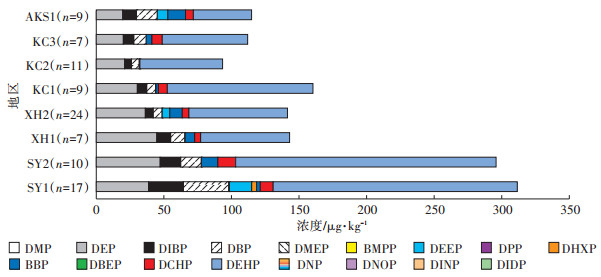
|
图 2 阿克苏不同采样区域土壤中PAEs平均浓度及成分 Figure 2 Average concentrations and components of phthalate esters (PAEs) in soils collected from eight areas of Akesu Region |
17种PAEs在阿克苏地区农产品8个采样区域的平均浓度和成分如图 3所示。8个采样区域浓度差异显著(P < 0.05),其中SY1、XH1比其他采样区域PAEs浓度高。SY1、XH1最高的PAEs浓度达到621.0 μg· kg-1和2 423.9 μg·kg-1。沙雅县(286.6 μg·kg-1)>新和县(244.5 μg·kg-1)>库车县(120.8 μg·kg-1)>阿克苏市(45.3 μg·kg-1),主要检出DEHP、DEP、DMP,从浓度上DMP>DEHP>DEP。
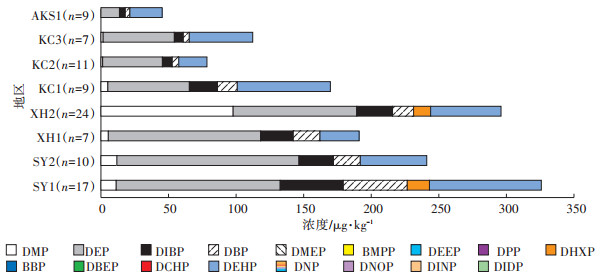
|
图 3 阿克苏不同采样区域农产品中PAEs平均浓度及成分 Figure 3 Average concentrations and components of phthalate esters (PAEs) in agro-products collected from eight areas of Akesu Region |
农产品按蔬菜、水果分类统计,蔬菜平均浓度220.1 μg·kg-1,水果182.2 μg·kg-1。按蔬菜的常规分类排序(图 4),根茎和芋薯类(534.7 μg·kg-1)>叶菜类(212.9 μg·kg-1)>其他蔬菜(甘蓝类、豆类和鳞茎类等)(195.6 μg·kg-1)>茄果类(167.3 μg·kg-1)>瓜果类(151.6 μg·kg-1)。各类蔬菜在检出PAEs组成上差异显著,DMP、DHXP浓度最高的为根茎和芋薯类,DEP和DEHP浓度最高的为叶菜类,叶菜类、茄果类、瓜果类、其他蔬菜(甘蓝类、豆类和鳞茎类等)和水果类均为DEP>DEHP>DIBP>DBP>DMP,根茎和芋薯类DMP> DEP>DHXP>DEHP>DIBP>DBP。农产品中DMP、DEP检出率和浓度高于土壤样品,可能是该类农产品吸收富集土壤中长链PAEs降解产物DMP的能力较强[23],土壤中DMP、DEP检出率较低和王明林在山东寿光的研究结果相同[24]。而采样土壤主要为沙壤,含水量5.36%~7.89%和土壤有机质含量、黏粒比都比较低,土壤对污染物吸附能力弱[16],农产品从土壤吸收的量就多[24]。
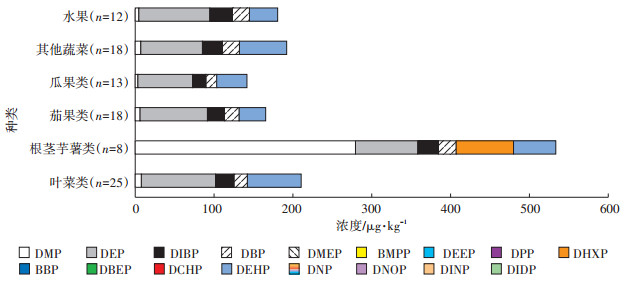
|
图 4 不同种类农产品中PAEs的平均浓度及成分 Figure 4 Average concentrations and components of phthalates esters in different agro-products |
研究发现阿克苏地区农产品ΣPAEs平均浓度为190 μg·kg-1,农产品中ΣPAEs浓度水平和之前的文献相比较低,本研究检出的PAEs根据Toxtree软件分析属于Cramer Ⅰ类化合物[25],毒性较小,为防止风险外溢,计算中未考虑6~11岁孩子蔬菜摄入量可能略小于成年人的摄入量,以及DMP、DEP等高溶解性和高蒸汽压的化合物在蔬果上洗涤和烹饪中的损失量。防止生殖毒性的最大允许摄入量均为30 μg·kg-1·d-1。因为PAEs属于环境激素,所以关注处于发育阶段的少年儿童,每个年龄体重参见中国首都儿科所青少年身高体重百分位数值表,6岁儿童21.26 kg,11岁儿童43.27 kg。蔬菜膳食消费习惯南北差异较大,选择北京和南京分别作为北方城市和南方城市的代表,没有对应分类的蔬菜和水果采用中国居民膳食指南蔬菜最低推荐摄入量为0.3 kg·d-1,水果推荐量为0.2 kg·d-1。北京、南京等城市调查所得蔬菜日摄入量均低于膳食指南推荐量,摄入量在0.067 8~0.113 kg·d-1范围内。经计算北京儿童日摄入量在0.084 2~1.911 4 μg·kg-1 BW·d-1,南京儿童日摄入量在0.084 2~1.677 5 μg· kg-1 BW·d-1,风险系数如表 2中所列,HI值均小于1,因此认为本次研究采集蔬果样品没有PAEs人体累计风险。
|
|
表 2 阿克苏蔬菜和水果中PAEs的人体累计风险评价 Table 2 Human cumulative risk assessment in vegetables and fruits collected from Akesu Region |
通过抽样检测,发现阿克苏地区土壤ΣPAEs平均浓度为180 μg·kg-1,根据美国土壤PAEs控制标准和治理标准(表 3),均未超标。与文献报道全国其他地区PAEs污染水平相比,新疆阿克苏地区土壤PAEs含量低于全国平均值,和郭冬梅等[21]报道的棉花地PAEs残留差距较大,推测原因是与抽样菜地平均地膜残留15.1 kg·hm-2和牛瑞坤等[20]报道的棉花地平均农膜残留134.09 kg·hm-2差异较大有关。
|
|
表 3 土壤中主要PAEs与土壤控制标准的比较(μg·kg-1) Table 3 Six phthalates concentration in Akesu Region soils compare with soil control standard in USA (μg·kg-1) |
在新疆阿克苏地区棉花种植结构调整为蔬菜水果后,覆膜保墒极为普遍,抽样土壤中残膜率平均为15.1 kg·hm-2,各采样区域间差异较大(表 4),平均残膜量0.1~42.1 kg·hm-2。平均膜厚5.6~6.85 μm,平均破碎度6.4~30.3 mg·块-1。
|
|
表 4 阿克苏各采样点平均残膜量、平均破碎度、平均膜厚 Table 4 verage plastic film residues, degree of size breakages, film thickness of Akesu Region |
地膜膜厚4.6~8.2 μm,破碎度7.3~37.9 mg·块-1,按照膜厚是否大于6.5 μm将测得的破碎度分成两组(表 5),两组破碎度平均值分别为17.3 mg·块-1和21.1 mg·块-1。最薄地膜样品厚度未达到地膜厚度0.008±0.003 mm的生产要求。地膜厚度仅达到生产标准GB 13735—1992《聚乙烯吹塑农用地面覆盖薄膜》地膜厚度0.008±0.003 mm的要求,未达到替代标准GB 13735—2017中地膜厚度不得小于0.010 mm的规定[26]。
|
|
表 5 阿克苏地膜残膜的不同膜厚和破碎度统计 Table 5 Different film thickness and degree of size breakages in Akesu Region |
所有数据利用IBM SPSS 22软件进行统计分析,相关性分析根据Kong[27]样品数(n=94)>30+(v+3)/2,v为变量的个数,表明分析结果是可信可靠的。农产品PAEs浓度和土壤PAEs浓度存在相关性,蔬果中ΣPAEs和土壤中ΣPAEs(n=94)在0.01水平上非参数检验显著正相关(R=0.529,P < 0.01)。8个采样点土壤-蔬菜平均值相关分析,在0.05水平非参数检验也呈显著正相关(R=0.762,P=0.028)。土壤、蔬果中的ΣPAEs和棉花种植时间上未发现相关性(P>0.05),土壤样品中ΣPAEs和残膜量非参数检验在0.05水平呈显著正相关(R=0.767,P=0.044)。地膜厚度5.6~6.85 μm范围,8个采样区域土壤ΣPAEs-膜厚平均值,SPSS相关分析,在0.05水平参数检验呈显著负相关(R=0.786,P=0.021)。土壤中ΣPAEs和破碎度在0.01水平上显著负相关(R=0.778,P < 0.01)。
Chen等[16]认为土壤PAEs浓度和Y(覆膜年限)、SOM(土壤有机质)、Clay-slit(黏粒比)、FeOx(铁氧化物)成正比。新疆土壤有机质含量平均14.65 g·kg-1,黏粒含量平均值为1.52%。有机质含量跟全国10个城市农地土壤有机质含量14.0~33.3 g·kg-1有差距,黏粒比和全国10个城市农地土壤63.9%~92.7%的差距更明显。在新疆地膜残留量高背景条件下,土壤PAEs含量仅考虑土壤理化性质还不全面。本研究SPSS相关性分析结果表明,土壤PAEs含量和农膜残留量呈正相关,和破碎度和农膜厚度呈负相关。因此新疆地区土壤PAEs浓度和X(农膜残留率)、SOM(土壤有机质)、Clay-slit(黏粒比)、FeOx(铁氧化物)、M(膜厚)的关系,参见公式(1)
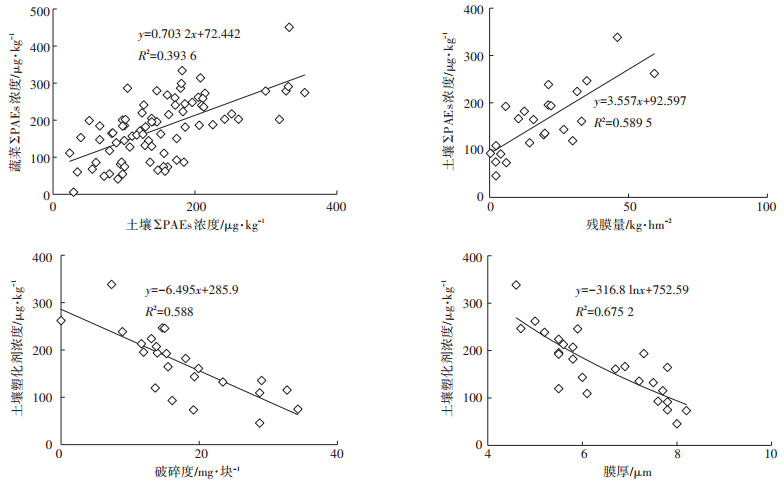
|
图 5 阿克苏地区土壤ΣPAEs与农产品ΣPAEs、残膜量、破碎度、膜厚的线性回归 Figure 5 Linear regressions of ΣPAEs in soils and ΣPAEs in agro-products, plastic film residues, degree of size breakages, mulch film thickness in Akesu Region |

|
(1) |
(1)阿克苏地区土壤样品中17种PAEs累积含量范围为0~1622 μg·kg-1,平均含量180.2 μg·kg-1,检出率95.7%,阿克苏地区农产品样品中17种PAEs累积含量范围为0~2 430.1 μg·kg-1,平均含量190.6 μg · kg-1,检出率93.6%。阿克苏地区残膜量0.1~ 42.1 kg·hm-2,残膜膜厚5.6~6.85 μm,破碎度6.4~ 30.3 mg·块-1。虽然新疆地区的地膜残留率高于国内其他地区,但是不同种类的蔬菜水果PAEs含量较低,经ADI暴露量评估,长期暴露其风险指数HI值不足以导致生殖毒性。
(2)阿克苏地区土壤、蔬果中的ΣPAEs浓度和棉花种植时间上未发现相关性(P>0.05)。蔬果中ΣPAEs和土壤中ΣPAEs(n=94)在0.01水平上非参数检验显著正相关(R=0.529,P < 0.01)。土壤样品中ΣPAEs和残膜量呈显著正相关(R=0.767,P=0.044),土壤ΣPAEs -膜厚平均值呈显著负相关(R=0.786,P= 0.021),土壤中ΣPAEs和破碎度呈负相关(R=0.778,P < 0.01)。农田残膜量、破碎度都和地膜膜厚有很直接的关系,提高地膜厚度有助于减少农田残膜量、土壤和农产品PAEs污染。相关性分析结果提示南疆棉花转产区PAEs污染关键控制点是降低农田残膜量。
致谢:
新疆农科院质标所王成研究员、何伟忠副研究员对采样方案设计和实施给予协助。贺泽英副研究员在英文摘要给予润色,张铁亮副研究员、王祖光同学参与了野外采样,在此一并表示感谢!
| [1] |
Chou K, Robert O W. Phthalates in food and medical devices[J]. Appl Toxicol, 2006, 2(3): 126-135. |
| [2] |
Hens G A, Caballos A M P. Social and economic interest in the control of phthalic acid esters[J]. TrAC Trends in Analytical Chemistry, 2003, 22(11): 847-857. DOI:10.1016/S0165-9936(03)01201-9 |
| [3] |
Lin Z P, Ikonomou M G, Jing H, et al. Determination of phthalate ester congeners and mixtures by LC/ESI-MS in sediments and biota of an urbanized marine inlet[J]. Environ Sci Technol, 2003, 37(10): 2100-2108. DOI:10.1021/es026361r |
| [4] |
Li X H, Ma L L, Liu X F, et al. Phthalate ester pollution in urban soil of Beijing, People's Republic of China[J]. Bull Environ Contam Toxicol, 2006, 77(2): 252-259. |
| [5] |
Wang J, Luo Y M, Teng Y, et al. Soil contamination by phthalate esters in Chinese intensive vegetable production systems with different modes of use of plastic film[J]. Environmental Pollution, 2013, 180(3): 265-273. |
| [6] |
Lovekamp-Swan T, Davis B J. Mechanisms of phthalate ester toxicity in the female reproductive system[J]. Environ Health Perspect, 2003, 111(2): 139-145. DOI:10.1289/ehp.5658 |
| [7] |
张建江, 舒为群. 邻苯二甲酸酯雌性生殖毒性研究进展[J]. 卫生研究, 2005, 34(4): 496-498. ZHANG Jian-jiang, SHU Wei-qun. Progress in phthalate ester toxicity in the female reproductive system[J]. Journal of Hygiene Research, 2005, 34(4): 496-498. DOI:10.3969/j.issn.1000-8020.2005.04.044 |
| [8] |
Wang Y X, Zeng Q, Sun Y, et al. Phthalate exposure in association with serum hormone levels, sperm DNA damage and spermatozoa apoptosis:A cross-sectional study in China[J]. Environmental Research, 2016, 150: 557-565. DOI:10.1016/j.envres.2015.11.023 |
| [9] |
Zhou J, Cai Z H, Xing K Z. Potential mechanisms of phthalate ester embryotoxicity in the abalone Haliotis diversicolor supertexta[J]. Environ Pollut, 2011, 159(5): 1114-1122. DOI:10.1016/j.envpol.2011.02.016 |
| [10] |
Su P H, Chang C K, Lin C Y, et al. Prenatal exposure to phthalate ester and pubertal development in a birth cohort in central Taiwan:A 12-year follow-up study[J]. Environ Res, 2015, 136: 324-330. DOI:10.1016/j.envres.2014.10.026 |
| [11] |
蔡全英, 莫测辉, 李云辉, 等. 广州、深圳地区蔬菜生产基地土壤中邻苯二甲酸酯(PAEs)研究[J]. 生态学报, 2005(2): 283-288. CAI Quan-ying, MO Ce-hui, LI Yun-hui, et al. The study of PAEs in soils from typical vegetable fields in areas of Guangzhou and Shenzhen, south China[J]. Acta Ecologica Sinica, 2005(2): 283-288. DOI:10.3321/j.issn:1000-0933.2005.02.016 |
| [12] |
曹志强, 刘敏. 我国农膜行业"十二·五"现状及"十三·五"发展规划[J]. 中国塑料, 2016, 30(8): 1-10. CAO Zhi -qiang, LIU Min. Situation of agricultural films during the 12th five-year plan period and their development prospect during the 13th five-year plan period in China[J]. China Plastics, 2016, 30(8): 1-10. |
| [13] |
鲁磊安, 陈学斌, 赵海明, 等. 珠三角地区稻田土壤和谷粒中邻苯二甲酸酯(PAEs)的分布特征及人体健康暴露风险[J]. 农业环境科学学报, 2016(7): 1242-1248. LU Lei-an, CHEN Xue-bin, ZHAO Hai-ming, et al. Distribution of phthalic acid esters (PAEs) in paddy soil and grains of rice in The Pearl River delta region and the health risk assessment[J]. Journal of Agro-Environment Science, 2016(07): 1242-1248. |
| [14] |
Li C, Chen J Y, Wang J H, et al. Phthalate esters in soil, plastic film, and vegetable from greenhouse vegetable production bases in Beijing, China:Concentrations, sources, and risk assessment[J]. Science of the Total Environment, 2016, 568: 1037-1043. DOI:10.1016/j.scitotenv.2016.06.077 |
| [15] |
Li K K, Ma D, Wu J, et al. Distribution of phthalate esters in agricultural soil with plastic film mulching in Shandong Peninsula, East China[J]. Chemosphere, 2016, 164: 314-321. DOI:10.1016/j.chemosphere.2016.08.068 |
| [16] |
Chen N, Shuai W J, Hao X M, et al. Contamination of phthalate esters in vegetable agriculture and human cumulative risk assessment[J]. Pedosphere, 2017, 27(3): 439-451. DOI:10.1016/S1002-0160(17)60340-0 |
| [17] |
Wang L J, Liu M M, Tao W D, et al. Pollution characteristics and health risk assessment of phthalate esters in urban soil in the typical semi-arid city of Xi'an, northwest China[J]. Chemosphere, 2018, 191: 467-476. DOI:10.1016/j.chemosphere.2017.10.066 |
| [18] |
雷亚平, 魏晓文, 刘志红. 中国棉花产业发展现状及展望[J]. 农业展望, 2014, 10(9): 43-47. LEI Ya-ping, WEI Xiao-wen, LIU Zhi-hong. Present status and outlook of cotton industry development in China[J]. Agricultural Outlook, 2014, 10(9): 43-47. DOI:10.3969/j.issn.1673-3908.2014.09.008 |
| [19] |
马瑛. 新疆棉花生产性废弃物处理方式的影响因素分析[J]. 中国农业资源与区划, 2016(1): 23-29. MA Ying. Analysis of influencing factors of treatment methods of cotton planting productive waste disposal in Xinjiang[J]. Chinese Journal of Agricultural Resources and Regional Planning, 2016(1): 23-29. |
| [20] |
牛瑞坤, 王旭峰, 胡灿, 等. 新疆阿克苏地区棉田残膜污染现状分析[J]. 新疆农业科学, 2016, 53(2): 283-288. NIU Rui-kun, WANG Xu-feng, HU Can, et al. Analysis on the status of plastic mulch-film residual in cotton fields in Akesu, Xinjiang[J]. Xinjiang Agricultural Sciences, 2016, 53(2): 283-288. |
| [21] |
郭冬梅, 吴瑛. 南疆棉田土壤中邻苯二甲酸酯(PAEs)的测定[J]. 干旱环境监测, 2011, 25(2): 76-79. GUO Dong-mei, WU Ying. Detemination of phthalic acid esters of soil in south of Xinjiang cotton fields[J]. Arid Environmental Monitoring, 2011, 25(2): 76-79. DOI:10.3969/j.issn.1007-1504.2011.02.003 |
| [22] |
新疆农业信息网.新疆连续三年调减棉花种植面积[EB/OL]. http://www.xj-agri.gov.cn/nongyeyw/22533.jhtml, 2017. Xinjiang Agricultural Information Network. Xinjiang reduced cotton planting area for three consecutive years[EB/OL]. http://www.xjagri.gov.cn/nongyeyw/22533.jhtml, 2017. |
| [23] |
Quan C S, Liu Q, Tian W J, et al. Biodegradation of an endocrine-disrupting chemical, di-2-ethylhexyl phthalate, by Bacillus subtilis No. 66[J]. Applied Microbiology and Biotechnology, 2005, 66(6): 702-710. DOI:10.1007/s00253-004-1683-6 |
| [24] |
王明林.蔬菜大棚中邻苯二甲酸酯分析方法及环境行为的研究[D].泰安: 山东农业大学, 2007. WANG Ming-lin. Research on analytical method and environmental behavior of PAEs in vegetable greenhouse[D]. Tai'an: Shandong Agricultural University, 2007. http://cdmd.cnki.com.cn/Article/CDMD-10434-2008206191.htm |
| [25] |
雍凌, 燕燕, 刘兆平, 等. 基于毒理学关注阈值方法的邻苯二甲酸二甲酯和邻苯二甲酸二乙酯的风险评估[J]. 中国食品卫生杂志, 2016, 28(2): 254-258. YONG Ling, YAN Yan, LIU Zhao-ping, et al. Risk assessment of dimethyl 1, 2-benzenedicarboxylate and 1, 2-benzenedicarboxylic acid diethyl ester with the threshold of toxicological concern approach[J]. Chinese Journal of Food Hygiene, 2016, 28(2): 254-258. |
| [26] |
中华人民共和国工业和信息化部. GB 13735-2017, 聚乙烯吹塑农用地面覆盖薄膜[S].北京: 中国国家标准化管理委员会, 2017. Ministry of Industry and Information Technology of PRC. GB 13735-2017, Polyethylene blown mulch film for agricultural uses[S]. Beijing: Standardization Administration of PRC, 2017. |
| [27] |
Kong S F, Ji Y Q, Liu L L, et al. Diversities of phthalate esters in suburban agricultural soils and wasteland soil appeared with urbanization in China[J]. Environmental Pollution, 2012, 170(8): 161-168. |
 2018, Vol. 37
2018, Vol. 37



